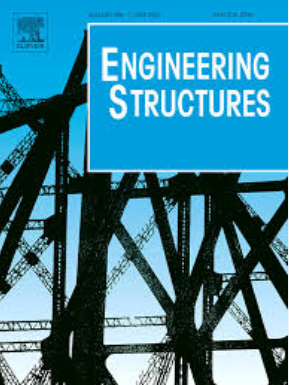冲击荷载作用下冻融损伤RC梁的试验与数值研究
IF 5.6
1区 工程技术
Q1 ENGINEERING, CIVIL
引用次数: 0
摘要
冻融循环引起的混凝土力学性能退化降低了桥梁的承载能力,引起了人们对其动力性能影响的关注。对冻融损伤钢筋混凝土梁进行了落锤冲击试验,研究了其破坏机理和抗冲击性能。考虑不同深度冻融损伤梯度引起的混凝土力学性能不均匀退化,建立了冲击荷载作用下RC梁的三维非线性有限元模型。利用验证的模型,探讨了FTCs数量、冲击速度、配筋率和箍筋率对FTCs作用下梁抗冲击性能的影响。随着冻融破坏程度的增大和冲击速度的增大,RC梁的破坏模式更多地由受弯破坏过渡到受剪破坏。增大配箍比的效果随着FTCs数量的增加而逐渐降低。增加配筋率降低了梁顶应力损伤程度,但对冻融损伤RC梁的局部刚度增加有限。本文章由计算机程序翻译,如有差异,请以英文原文为准。
Experimental and numerical investigation of freeze-thaw damaged RC beams subject to impact loading
The degradation of concrete mechanical properties induced by freeze-thaw cycles (FTCs) reduces bridge load-bearing capacity, prompting much concern about their impact on dynamic behavior. Drop-weight impact tests on freeze-thaw damaged reinforced concrete (RC) beams were conducted, and failure mechanisms and impact resistance were investigated. Considering the non-uniform degradation of concrete mechanical properties, caused by freeze-thaw damage gradients at different depths, a three-dimensional nonlinear finite element model for RC beams under impact loads was established. Using the validated model, the effects of the number of FTCs, impact velocities, reinforcement ratios, and stirrup ratios on the impact resistance performance of the beam subjected to FTCs were explored. As the degree of freeze-thaw damage increased and impact velocity rose, the failure mode of RC beams became more transitioned from flexural to shear failure. The effectiveness of increasing the stirrup ratio gradually decreased with the increase in the number of FTCs. Increasing the reinforcement ratio reduced the extent of stress damage at the top of the beam, but provided a limited increase to the local stiffness of freeze-thaw damaged RC beams.
求助全文
通过发布文献求助,成功后即可免费获取论文全文。
去求助
来源期刊

Engineering Structures
工程技术-工程:土木
CiteScore
10.20
自引率
14.50%
发文量
1385
审稿时长
67 days
期刊介绍:
Engineering Structures provides a forum for a broad blend of scientific and technical papers to reflect the evolving needs of the structural engineering and structural mechanics communities. Particularly welcome are contributions dealing with applications of structural engineering and mechanics principles in all areas of technology. The journal aspires to a broad and integrated coverage of the effects of dynamic loadings and of the modelling techniques whereby the structural response to these loadings may be computed.
The scope of Engineering Structures encompasses, but is not restricted to, the following areas: infrastructure engineering; earthquake engineering; structure-fluid-soil interaction; wind engineering; fire engineering; blast engineering; structural reliability/stability; life assessment/integrity; structural health monitoring; multi-hazard engineering; structural dynamics; optimization; expert systems; experimental modelling; performance-based design; multiscale analysis; value engineering.
Topics of interest include: tall buildings; innovative structures; environmentally responsive structures; bridges; stadiums; commercial and public buildings; transmission towers; television and telecommunication masts; foldable structures; cooling towers; plates and shells; suspension structures; protective structures; smart structures; nuclear reactors; dams; pressure vessels; pipelines; tunnels.
Engineering Structures also publishes review articles, short communications and discussions, book reviews, and a diary on international events related to any aspect of structural engineering.
 求助内容:
求助内容: 应助结果提醒方式:
应助结果提醒方式:


